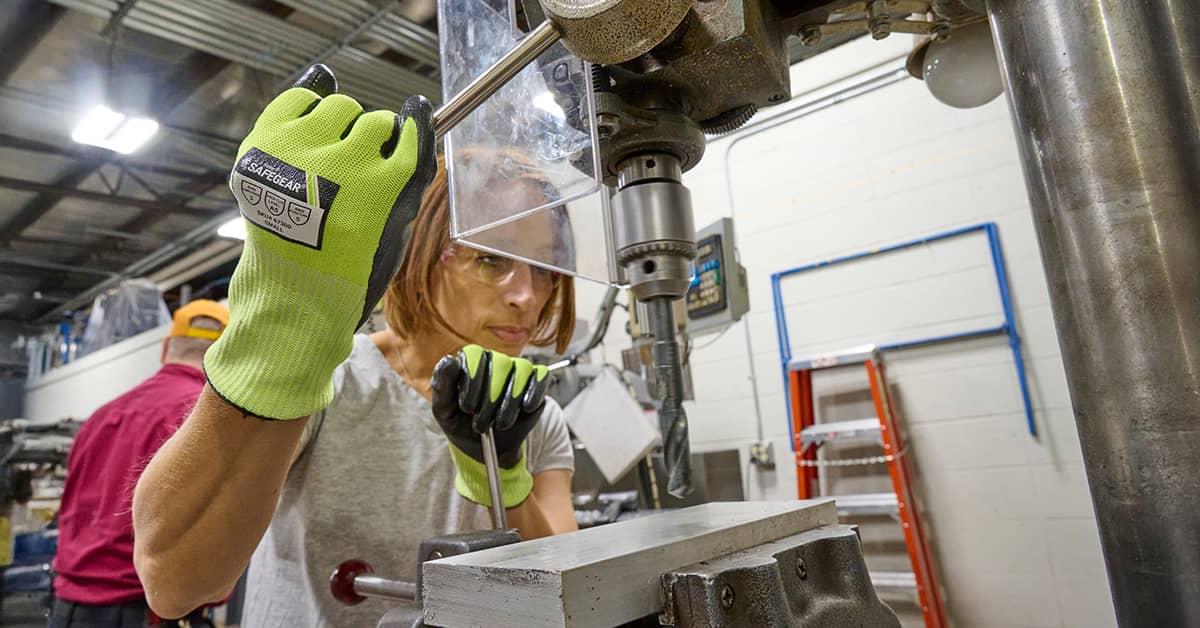Motions and actions that must be guarded
Date Posted: 08/25/2025

Machine guards protect the operator and other employees in the area from hazards created by ingoing nip points, rotating parts, flying chips, and sparks. A variety of mechanical motions and actions may create hazards.
The types of hazardous motions and actions are common to nearly all machines, though in differing combinations. Recognizing them is the first step toward protecting workers. The basic types of hazardous mechanical motions and actions are as follows:
Motions
- Rotating motion can be dangerous. Even slowly rotating shafts can grip hair and clothing. Rotating mechanisms include collars, couplings, cams, clutches, flywheels, shaft ends, spindles, meshing gears, and horizontal or vertical shafting. The danger increases when bolts, abrasions, or other projections are exposed on rotating parts.
- In-running nip point hazards are caused by the rotating parts. Rotating parts may be in contact or in close proximity. For instance, stock fed between two rolls produces a nip point. Other examples would be the point of contact between a power transmission belt and its pulley, or a chain and sprocket. Nip points can also occur between rotating and fixed parts which create a shearing, crushing, or abrading action. Examples are spoked handwheels or flywheels, screw conveyors, or the space between an abrasive wheel and an incorrectly adjusted work rest.
- Reciprocating motions may be hazardous because, during the back-and-forth or up-and-down motion, a worker may be struck by or caught between a moving and a stationary part.
- Transverse motion is movement in a straight, continuous line. It creates a hazard because a worker may be struck or caught in a pinch or shear point by the moving part.
Actions
- Cutting action may involve rotating, reciprocating, or transverse motion. Hazards are present at the point of operation in cutting wood, metal, and other materials. Examples include various types of saws, boring and drilling machines, lathes, or milling machines.
- Punching action results when power is applied to a slide (ram) for the purpose of blanking, drawing, or stamping metal or other materials.
- Shearing action involves applying power to a slide or knife in order to trim or shear metal or other materials.
- Bending action results when power is applied to a slide in order to draw or stamp metal or other materials. A hazard occurs at the point of operation where stock is inserted, held, and withdrawn. Example equipment includes power presses, press brakes, and tubing benders.
Although most machines present one or more of the above hazards, effective guards may differ considerably for each type of machine. Understanding the motions and actions that can create hazards is an important first step to properly applying OSHA’s guarding requirements.
How Safety Management Suite Can Help
Any machine part, function, or process that may cause injury must be safeguarded, yet each workplace and situation is unique. The Discussion Tool in the J. J. Keller® SAFETY MANAGEMENT SUITE is a great place to pose your machine guarding questions and get feedback from your peers on what works for them. They may have best practices and suggestions around this topic.
E-mail Newsletter
Sign up to receive the weekly EHS Insider email newsletter for safety articles, news headlines, regulatory alerts, industry events, webcasts, and more.